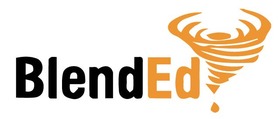Persuasive Techniques & Rhetoric (Logos, Ethos, Pathos)
Persuasive Techniques & Rhetoric (Logos, Ethos, Pathos)Title and Description
Persuasive Techniques & Rhetoric (Logos, Ethos, Pathos) was developed by Jen Kastanek as part of the Nebraska ESUCC Special Project for BlendEd Best Practices.
Content Area Skill:
English 9-10
Digital Age Skill(s):
Creative Communicator
Duration of Unit:
15 +/- days
Overview of Unit:
In this unit, students will …
1. Define, identify, analyze, and effectively use four persuasive techniques.
2. Define, identify, analyze, and effectively use persuasive rhetoric.
3. Effectively use the writing process to create a persuasive essay and persuade the reader of their position on an established topic.
4. Extend their knowledge of persuasive techniques and rhetoric to create a real-world multimedia product using or teaching persuasion.
Empower Learners:
| Content Area Skills: | Student Friendly Learning Objectives: |
| LA 10.1.6.c Analyze the function and critique the effects of the author‘s use of literary devices (e.g., simile, metaphor, personification, idiom, oxymoron, hyperbole, alliteration, onomatopoeia, analogy, dialect, tone, mood). | I can examine and critique the author’s use of literary text. |
| LA 10.1.6.f Interpret and evaluate information from print and digital text features to support comprehension. | I can explain the meaning and evaluate the usefulness of the information provided by text features. |
| LA 10.1.6.i Construct and/or answer literal, inferential, critical, and interpretive questions, analyzing and synthesizing evidence from the text and additional sources to support answers. | I can ask and answer a variety of question types using evidence from the text and other sources. |
LA 10.1.6.k Select text for a particular purpose (e.g., answer a question, solve problems, enjoy, form an opinion, understand a specific viewpoint, predict outcomes, discover models for own writing, accomplish a task), citing evidence to support analysis, reflection, or research. |
I can select a text for a specific purpose and cite evidence to support analysis, reflection, and research. |
| LA 10.2.2 Writing Modes: Students will write in multiple modes for a variety of purposes and audiences across disciplines. | I can write in multiple modes for a variety of purposes and audiences using varied media and formats. |
LA 10.2.1 Writing Process: Students will apply the writing process to plan, draft, revise, edit, and publish writing using correct spelling, grammar, punctuation, and other conventions of standard English appropriate for grade-level. |
I can apply the writing process to create an effective, finalized piece of writing. |
Empower Learner Activity:
Detailed Description:
Stickers on the Wall: Objective options are listed on a large sticky pad on the wall. Students place their sticker at the appropriate level they feel describes them. This is repeated after every learning step. (Image1 Image2 of the finished chart here).
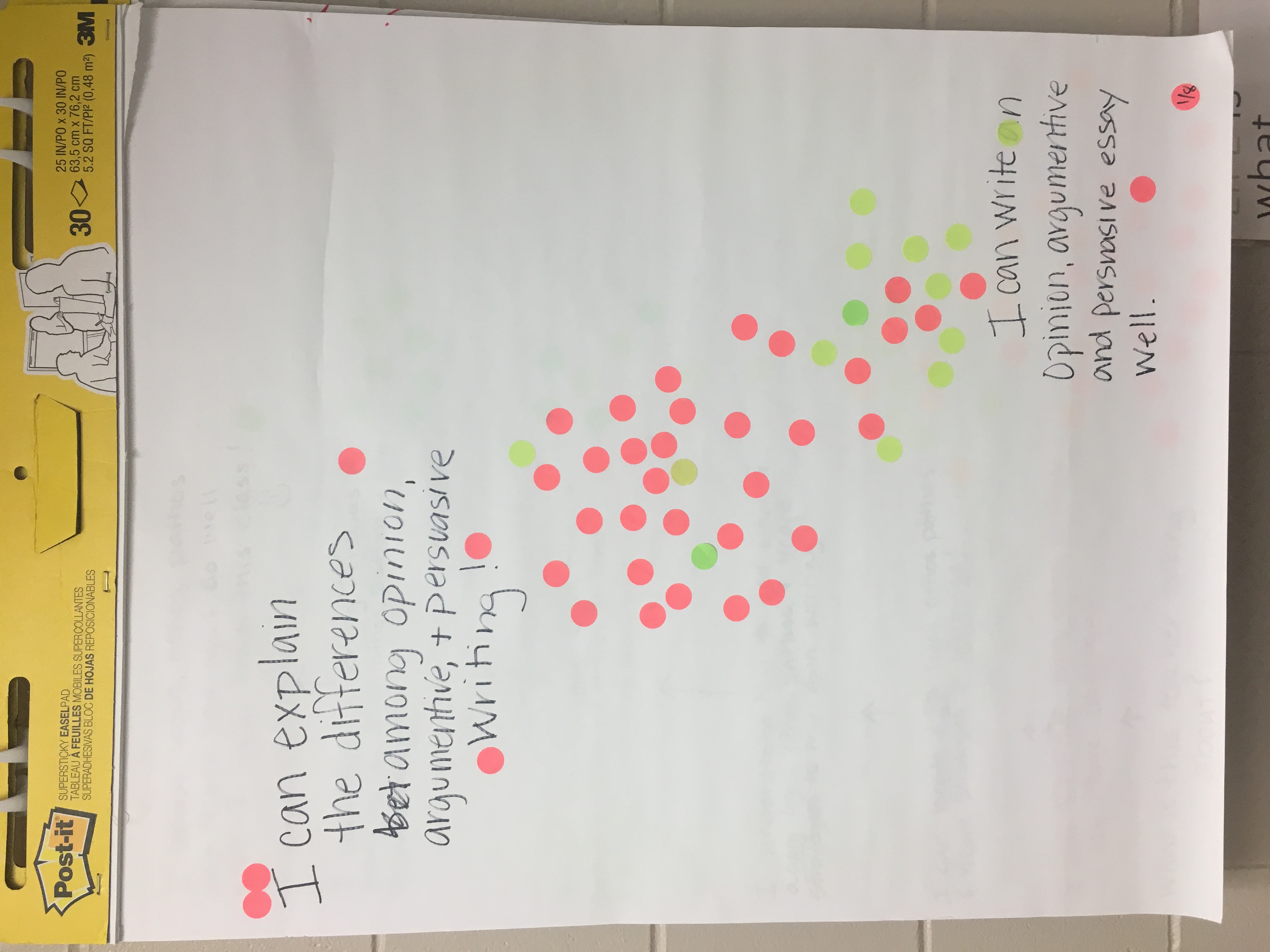
Proficiency - Student Scale
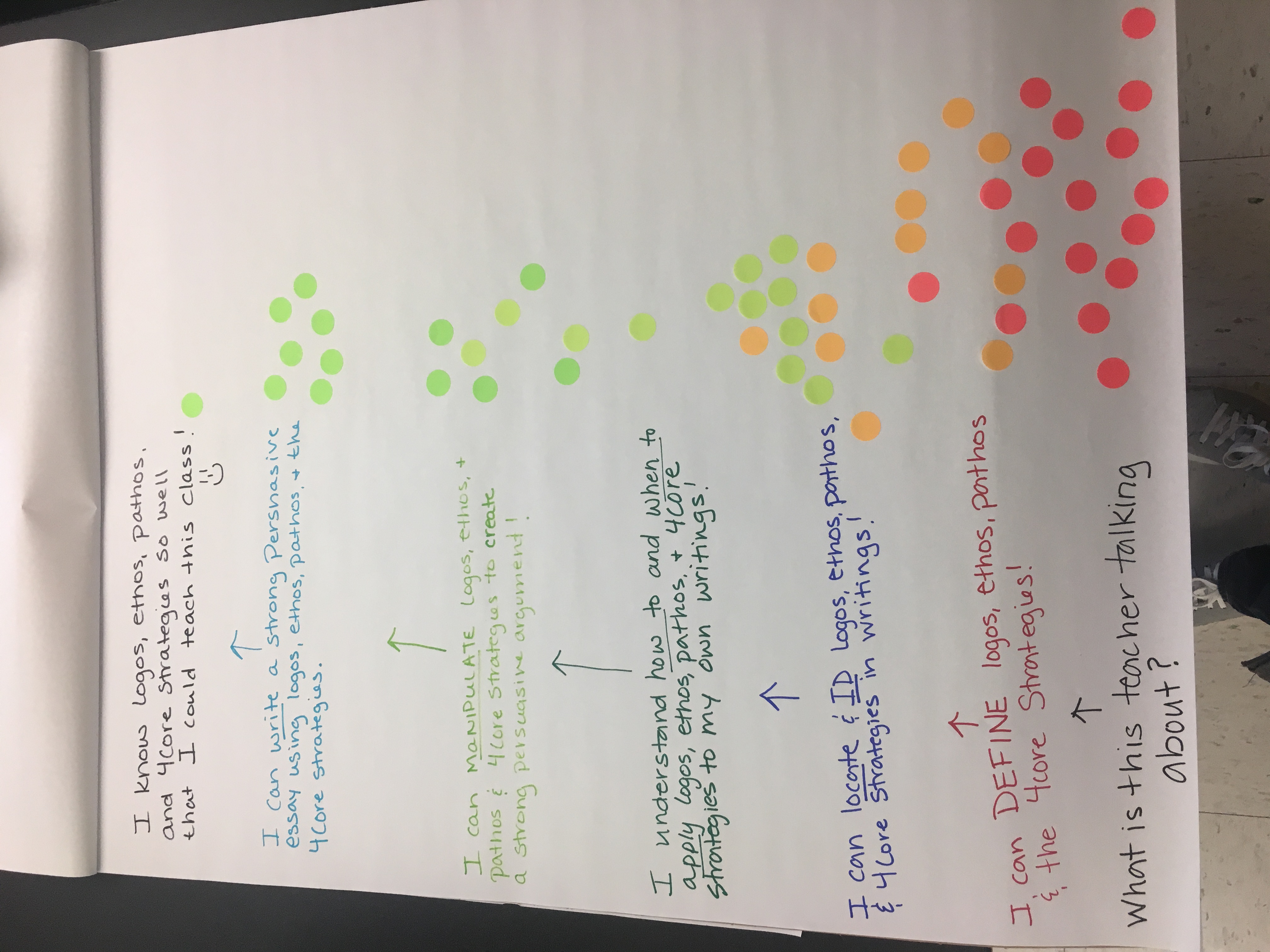
Proficiency Detailed - Student Rate
Knowledge Application:
Artifact Profile:
Student made video or YouTube advertisement
Detailed Description:
Student(s) will create a video/flipped lesson/PowToon demonstrating understanding of persuasive techniques and persuasive rhetoric.
https://docs.google.com/document/d/1G35uwZQ-5QEialcN6iw47BmpTba90xt_O30-Rxu13iI/edit?usp=sharing
Students create an 8x10 poster/graphic with a QR code linked to their final artifact. Posters will be displayed and students will have the opportunity for a gallery walk to present their work. Observers can fill out a feedback form for three projects and a self-reflection form or Flipgrid.
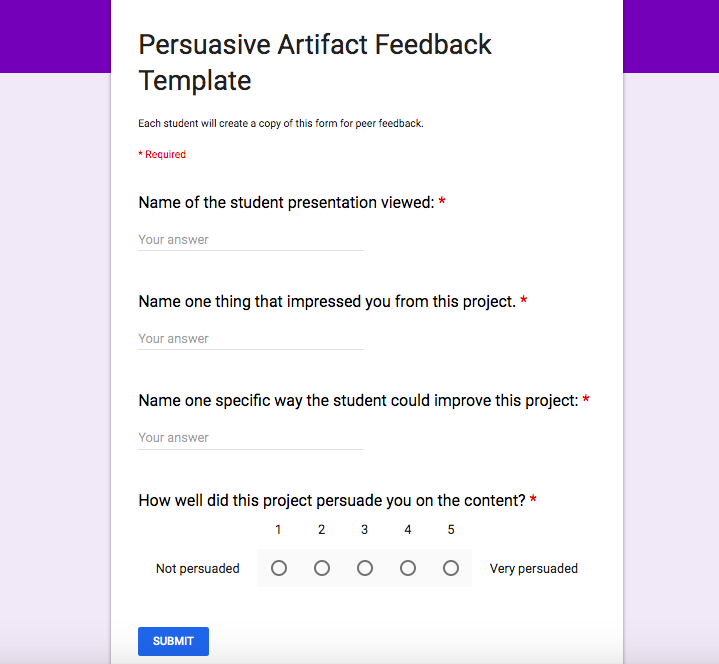
Persuasive Artifact Feedback Template
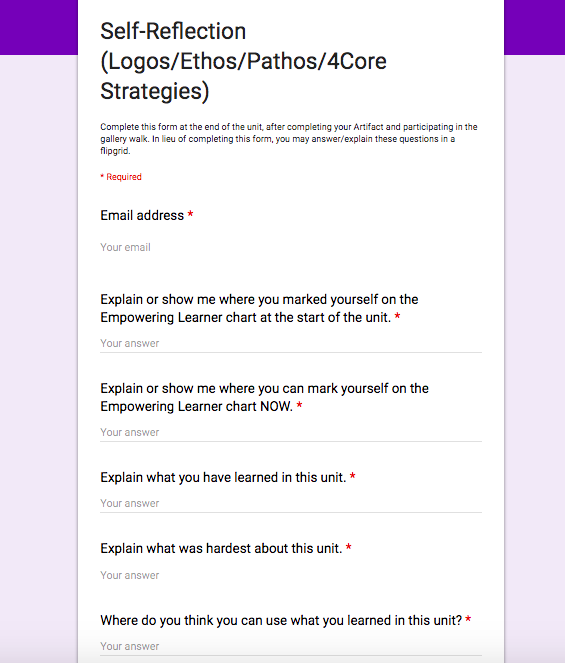
Self-Reflection (Logos/Ethos/Pathos/4 Core Strategies)
Content Area Skills Addressed:
10.1.5, 10.1.6, 10.2.2, 10.3.3
Digital Age Skills
Creative Communicator
Link to Rubric
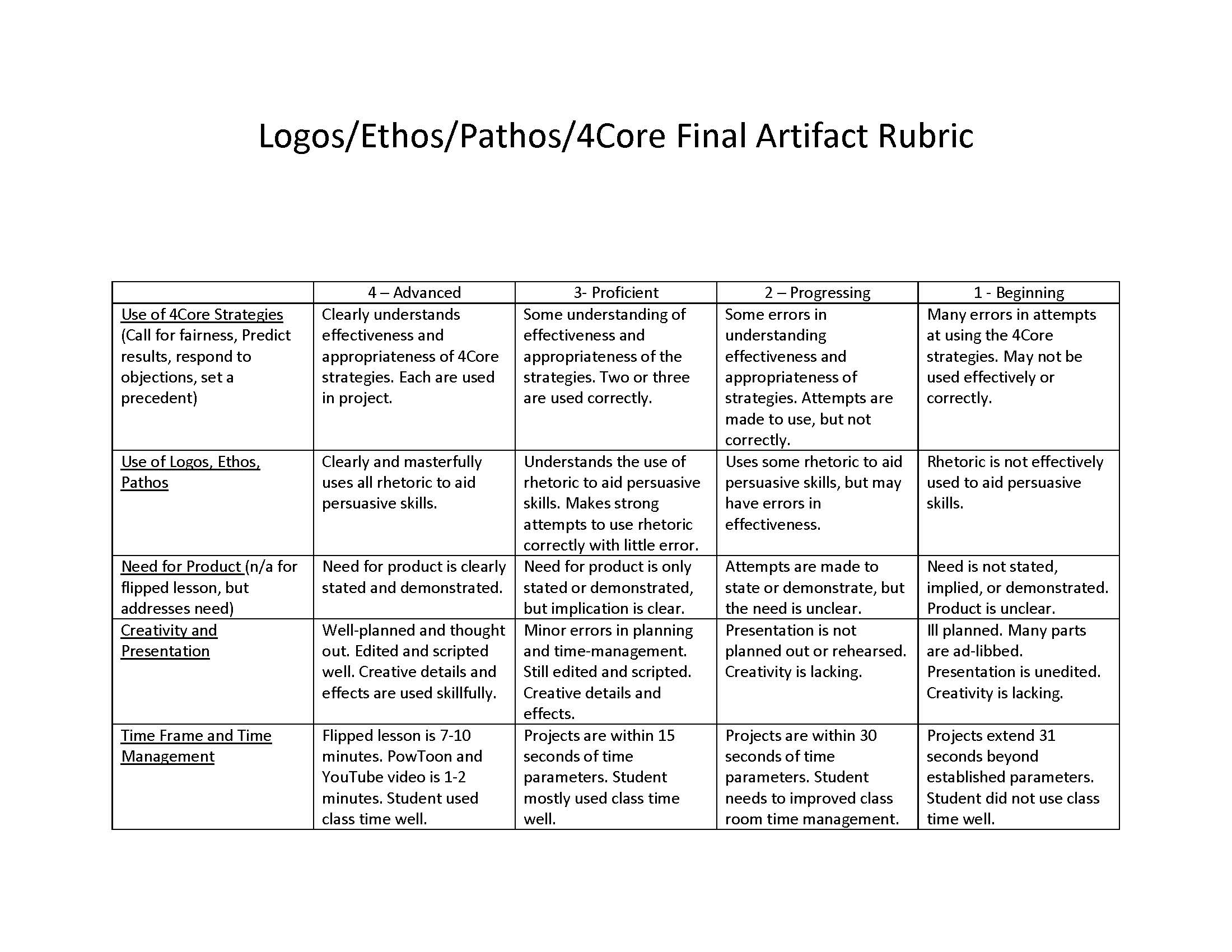
Artifact Rubric
Knowledge Deepening:
Task 1: Identifying Logos/Ethos/Pathos in TV Commercials\Print media (Station Rotation & Whole Group instruction)
Students view various television commercials and ID what rhetoric is being utilized in the commercial. Can be done as combination whole class or station rotation with each rotation viewing a link to a particular video (see Learning Path day 3-4 for details). Students can discuss various questions concerning the effectiveness of the commercials in small groups. Last station would be whole group to check understanding and provide self-reflection. (I do, we do, you do method) Tasks
| Must Do’s: Schmoop video - whole class discussion. Commercial examples Pathos, Pathos Ethos, Ethos Logos, Logos Students must label and explain why for their choice of commercials. |
May Do’s: Practice CCSS terms |
Resources: See Learning Path day 3-4 |
Task 2: ID Logos, Ethos, Pathos in Speeches
Students use the playlist to practice annotating, identifying and analyzing the effectiveness of Logos, Ethos, and Pathos in speeches.
| Must Do’s: Master ID in at least one speech with a 80% accuracy. Complete analysis questions. |
May Do’s: Comprehension questions (individual or group) |
Resources: |
Task 3: ID 4Core Strategies in editorials
Introduce 4Core persuasive strategies.
Must Do’s: Master ID Logos, Ethos, Pathos with 90% mastery. ID 4Core persuasive strategies correctly w/ 80% mastery. Complete Persuasive Techniques Test with 70%. |
May Do’s: Refer back to speeches in Task 2 to determine if 4Core strategies were used. |
Resources: Test |
Direct Instruction:
Learning Path:
| Day # | Description | BlendEd Model | Resources |
| 1 | 1. Canvas free write, discussion, reflection 2. Empower Learner chart 3. Small groups (Activate prior knowledge - brainstorm differences among opinion/fact, argument, persuasive). Then use the handout to fill in learning gaps. Then, we will have whole group discussion. |
Whole group rotation | Large Post-It board, dots stickers |
| 2 | 1. Define CCSS Terms - Whole Group instruction (notes) - Provide practice (WizerMe practice worksheet, Quizlet) - Students must pass the matching test with 75% (many versions). Retake until mastered. |
Whole group instruction, independent practice | CCSS terms |
| 3-4 | Introduce Logos, Ethos, Pathos 1. Schmoop video - whole class discussion 2. I do. Commercial examples 3. TASK 1 (We do) - Small Group Station Rotation - View Super Bowl commercial compilations and determine logos, ethos, pathos. - Use magazines to determine logos, ethos, pathos in print ads. - Practice CCSS terms (see day 2)/Reflection w/teacher - empower learner chart(formative assessment). |
Whole group, Station Rotation | Variety of magazines w/ advertisements. |
| 5-7 | TASK 2 - ID Logos, Ethos, Pathos in Speeches Students work through the playlist choices at own pace. Will conference after completion of choice. (formative assessment) |
Flex Model | Playlist |
| 8 | 1. Introduce 4Core persuasive strategies - handout. (front) (back) 2. Whole group modeling with essay 3. Using persuasive language - discussion/handouts |
Whole group instruction Flipped Lesson |
|
| 9-11 | TASK 3 - ID 4Core Strategies in editorials 1. DAY 1: (in pairs): students practice identifying 4Core strategies in choice of article (from choice board). Students MAY work together to find Core4 strategies from previous speeches. 2. DAY 2-3: (3 rotations): - Individual seatwork: students independently work on identifying 4Core strategies in the article of choice. - Practice/review CCSS terms with classmates. - Conference with Mrs. Kastanek (check work/progress/growth/formative assessment-empower learner chart). |
Whole Group rotations/Station Rotations | Choice Board |
| 12 | Assessment (summative assessment) | Test(s) | |
| 13-15 | Knowledge Application Artifact (summative assessment) | (see Artifact Profile above) |
Resources:
See above.
